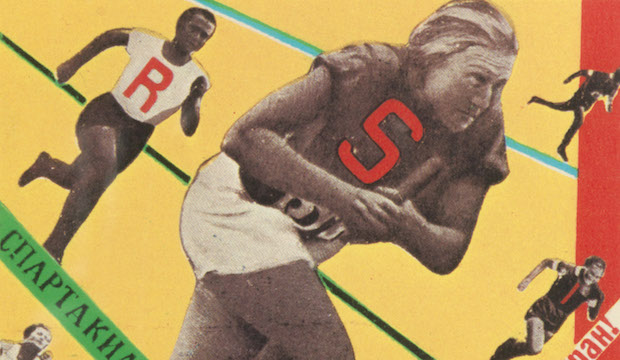
Red Star Over Russia proves that there is always more to learn about this country’s history which seems as vast and varied as Russia itself.

Gustav Klutsis, Moscow All-Union Olympiad, 1928
Through six large rooms, the multi-media material stretches from the first attempt to overthrow the Tsar in 1905 up to the relatively more liberal post-Stalin period, known as the ‘Thaw’.
Choosing not to dwell on the economic havoc wreaked by the Bolshevik takeover, the exhibition tells instead the story of how Russia swung violently from optimism to political terrorism and paranoia under Stalin and back again over the course of fifty years.
In the first couple of rooms, the enthusiasm for the heady days of the new Soviet state is palpable. Propaganda seems a dirty word today but then art with an unashamedly political focus was at the very forefront of the avant-garde.
These striking propagandist posters command your attention with colour — plenty of Communist red here — and imagery that shout as loudly as their titles: Emancipated Woman: Build Socialism!; Raise Higher the Banner of Marx, Engels, Lenin and Stalin!; Death to World Imperialism.

Valentina Kulagina, WAIT, Soviet Art Exhibition, 1931
The latter piece reveals these artists’ surprising outward looking character. For them, Russia’s revolution was an international event. To further pull out this thread, the exhibition shines a light on the publication of USSR in Construction, one of the first international illustrated magazines. The issues were translated into several languages and bristle with impossibly cool photography and designs from Aleksandr Rodchenko and his Varvara Stepanova. Their excitement leaps from the page.
This multilingual, multicultural and collaborative vision would be submerged as the communist nation dragged itself into the 30s under Stalin and wouldn’t be picked again until the 1940s when the much-feared conflict with Hitler’s Germany became reality.
The need for a bold return to an earlier dynamism is particularly strong in the posters of Nina Vatolina — collector David King’s favourite artist — where images of the increasingly unpopular Stalin were exchanged for the ‘Motherland’ in order galvanise the public in the ‘struggle against fascism’.
These more colourful works are reserved for the final room while the exhibition spends time exploring the history of the Union, told mainly through a series of small artefacts — posters, postcards, photos, letters — that would have littered people’s homes.

Gustav Klutzes, Raise Higher the Banner of Marx, Engels, Lenin and Stalin!, 1933
One of the exhibition’s more memorable displays discards with labels completely. A bank of mugshots of Stalin’s ‘enemies of state’ from the Gulag prior to their execution are left without names or numbers, which are provided in catalogues separately. Without identification, these citizens’ stares hold you uncomfortably.
This showcase of portraits is the centre piece of the room exploring the ways in which Soviet Russia erased traces of enemies through image manipulation.
On the whole, the team at Tate Modern have succeeded in the tough task of making a private collection amassed over several decades cohere and make sense. King’s personal interests hover behind Red Star Over Russia, so you may have to share his enthusiasm to really enjoy certain corners of this exhibition.
But generous and honest, Red Star Over Russia leaves a lasting impression of turbulent times that were as colourful and creative as they were cruel.
| What | Red Star Over Russia, Tate Modern, review |
| Where | Tate Modern, Bankside, London, SE1 9TG | MAP |
| Nearest tube | Southwark (underground) |
| When |
08 Nov 17 – 18 Feb 18, Open Fridays 10am - 10pm |
| Price | £13.30 |
| Website | Please click here for more information |



